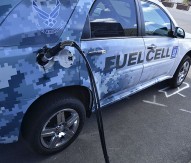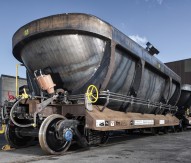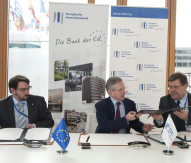

Dr Emile Greenhalgh © Imperial College London
Storing energy in Horizon 2020
A key problem identified with electric cars is their lack of range and the need to regularly charge the on-board batteries. To improve range, the natural solution is to install more batteries, although this increases the weight of the vehicle, thereby requiring more energy to power the car – a vicious circle.
The €3.3m FP7 Composite Structural Power Storage for Hybrid Vehicles (STORAGE) project aims to provide a more practical and innovative solution by developing materials that allow the vehicle’s structure to store and discharge energy. The project is co-ordinated by Dr Emile Greenhalgh at Imperial College London, the largest contributor to the project, who began by explaining the background to the FP7 programme.
Multifunctional materials fall into two groups: multifunctional structures, where you have a battery embedded within the structure, and materials which themselves provide this simultaneous role, which potentially gives a much higher performance. It’s a very generic technology that could apply not only to transportation, but also to electronic safety devices too, anything where you need to minimise mass in a product that needs electrical energy.
After undertaking an initial feasibility study and being able to demonstrate that the technology actually worked, we approached various funding bodies to try to take the technology forward. Our product crosses two technological fields – mechanical and electrical engineering, and people in each profession initially struggled to understand what we were doing.
Subsequently, we have managed to secure funding from the UK Ministry of Defence (MoD) and we then put together a consortium in order to apply for FP7 transportation funding. The grouping includes Swedish battery manufacturer ETC; material manufacturer NANOCYL from Belgium; global chemicals and materials company CYTEC, based in the UK; Swedish research organisation SWEREA SICOMP; INASCO in Athens; Chalmers University in Gothenburg; and car manufacturer Volvo, which acts as an end user.
How important has FP7 funding been to the project?
It’s been vital – we received €1m of funding from the European Commission. Volvo has received a huge amount of publicity from the project, which has helped maintain momentum for the development. I think it has also helped by having a goal at the end and an actual technology demonstrator so everyone can see the science that we are doing, which will ultimately lead to a final product.
How do you think Horizon 2020 could benefit your FP7 project?
Our project still has a long way to go on the TRL scale and I would estimate we are at level four or five; it takes a lot of resources to develop a final product. I am also concerned that at the high levels of the TRL scale, issues such as IPR may become an issue, particularly in consortiums. When working on a generic scientific problem, no one is too concerned about the IPR in the early stages. Yet when developing technology very specific to a product, I envisage IPR becoming a key issue.
Our project is due to close at the end of June. I think if Horizon 2020 is focusing on getting more products to market, that is certainly encouraging because that is what really has been driving the STORAGE project. We still have funding from the UK MoD, but we are also looking at creating a further consortium in Horizon 2020 in order to take this technology forward. We need to draw upon expertise across Europe rather than just within the UK. The production of carbon nanotubes, loading materials and the expertise that Volvo has provided is very specialist and not something that can be done on a national level; I think that we would struggle in the UK to get the breadth of expertise needed. The growth fields of research are often these multidisciplinary areas and you cannot find the expertise in one country.
We have made enormous leaps forward with the EU funding we have received, not only developing the science of the materials, but also developing an engineering methodology. Certainly, in the 26 years of research I’ve done, this is probably the most exciting area that I have worked in.
Dr Emile Greenhalgh






